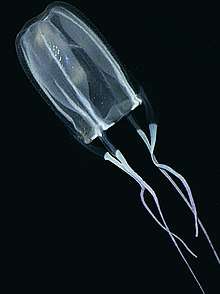Carukiidae
Carukiidae is a family of box jellyfish within the Cubozoa class.[1] Carukiidae can be easily classified by their lack of cirri clumps inside the cubozoan stomach, as well as the size and the placement of their nematocysts.[2]
| Carukiidae | |
|---|---|
 | |
| Morbakka virulenta Seto, Japan | |
| Scientific classification | |
| Kingdom: | Animalia |
| Phylum: | Cnidaria |
| Class: | Cubozoa |
| Order: | Carybdeida |
| Family: | Carukiidae |
| Genera | |
|
See text | |
Carukiidae use nematocysts as a defense mechanism; they releases a venom from the tips of their nematocysts, producing the Irukandji syndrome.[3] Even though positions of spines on the shaft of the Carukiidae cause illness, there are areas on the body that do not. The rhopalial niche openings, which discern light, do not incur any illness. The Carukiidae also have non-venomous rhopaliar horns, which are imperceptive in function and located above the rhopalial niches.[2]
Irukandji syndrome triggered by Carukiidae requires immediate medical attention. In the event that it goes untreated in humans, cardiac arrest is a potentially deadly consequence.[4]
Classification
- Carukia
- Carukia barnesi (Southcott, 1967)[5]
- Carukia shinju (Gershwin, 2005)[6]
- Gerongia
- Gerongia rifkinae (Gershwin & Alderslade, 2005)[7]
- Malo
- Malo kingi (Gershwin, 2007)
- Malo maximus (Gershwin, 2005)[6]
- Malo filipina (Bentlage & Lewis, 2012)[8]
- Malo bella (Gershwin, 2014)[9]
- Morbakka
- Morbakka fenneri (Gershwin, 2008)
- Morbakka virulenta (Kishinouyea, 1910)[10]
References
- Collins, Allen G. (2010). Carukiidae. Accessed through: World Register of Marine Species at http://www.marinespecies.org/aphia.php?p=taxdetails&id=484724 on 2011-09-21
- Lesser, Michael (2013). Advances in Marine Biology, Volume 66. Academic Press. p. 12. ISBN 9780124080966.
- Lesser, Michael (2013). Advances in Marine Biology, Volume 66. Academic Press. p. 21. ISBN 9780124080966.
- "Irukandji syndrome". LITFL • Life in the Fast Lane Medical Blog. 2008-12-18. Retrieved 2018-04-20.
- Southcott, R.V. (1967). "Revision of some Carybdeidae (Scuphozoa : Cubomedusae) including a description of the jellyfish responsible for the 'Irukandji syndrome'". Australian Journal of Zoology. 15 (3): 651-671. doi:10.1071/ZO9670651.
- Gershwin, L. (2005). "Two New Species Of Jellyfishes (Cnidaria: Cubozoa: Carybdeida) From Tropical Western Australia, Presumed To Cause Irukandji Syndrome". Zootaxa. 1084 (1084): 1-30. doi:10.5281/zenodo.170452.
- Gershwin, Lisa-Ann; Alderslade, Phil (2005). "A new genus and species of box jellyfish (Cubozoa: Carybdeida) from tropical Australian waters". The Beagle, Records of the Museums and Art Galleries of the Northern Territory. 21: 27–36.
- Bentlage, Bastian; Lewis, Cheryl (2012). "An illustrated key and synopsis of the families and genera of carybdeid box jellyfishes (Cnidaria: Cubozoa: Carybdeida), with emphasis on the "Irukandji family" (Carukiidae)". Journal of Natural History. 46 (41–42): 2595–2620. doi:10.1080/00222933.2012.717645.
- Gershwin, Lisa-Ann (2014). "Two new species of box jellies (Cnidaria: Cubozoa: Carybdeida) from the central coast of Western Australia, both presumed to cause Irukandji syndrome". Records of the Western Australian Museum. 29 (1).
- Kishinouyea, K. (1910). "Some medusae of Japanese waters". Journal of the College of Science, Imperial University of Tokyo. 27: 1-35, Pl.1-5.
- "Carukiidae" at the Encyclopedia of Life